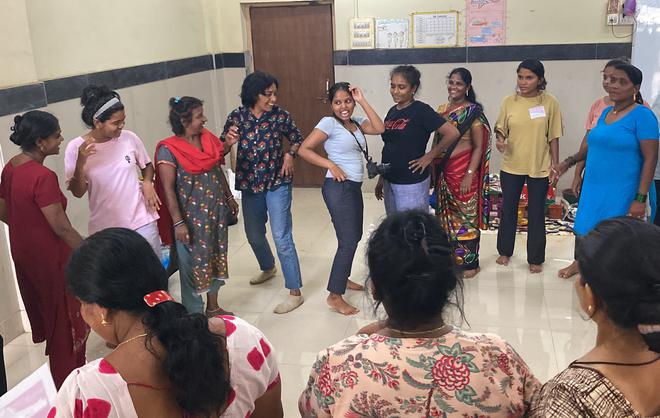“Art is about broadcasting yourself to the world,” says Bengaluru-based artist Girija Hariharan, who firmly believes that it can drive social change. It is at the core of what Mumbai-based collective Haan Hum, which she is part of, seeks to do: enable sex workers, who are often marginalised and exploited, to experience the creative freedom that art and theatre can offer, which, in turn, could help them gain “a unique perspective into themselves, can spark an awareness of their oppression, and eventually start them towards a journey of liberation, in whatever form they choose to pursue,” as the Haan Hum website puts it.
The genesis of the project dates back to 2021, when Ms. Hariharan, who is known for painting layered street murals, with definite social and cultural undertones, began travelling with a feminist collective called Hers is Ours across Rajasthan and Agra. “We were visiting multiple villages, doing film screenings and creating art,” she says, adding that she had created a period mural in one of these villages to drive home a message that “getting a period shouldn’t stop you from pursuing life.”

On this trip, Ms. Hariharan also met Trina Talukdar, who had co-founded Kranti, an organisation that empowers girls from Mumbai’s red-light area to become agents of social change. A few months later, in 2022, she was contacted by Ravi Kantamsetty, from Save the Child foundation, who had seen her period mural and wanted her to create another mural in Kamathipura. ”Save the Child, which provides grants to several NGOs working towards gender equality, including Kranti, felt that a mural was an effective way to promote issues,” says Ms. Hariharan.

Owning their space
When she visited the site in Mumbai, however, she realised something: no one would connect to the mural in that space, “Since all the sex workers live in the corners of Kamathipura and don’t have the time to consume art.” Although she had already visited Kranti, seen the wall and even gotten permission from the school whose wall she was supposed to paint, this realisation made her rethink the idea of a mural.
“I want them to get the sex workers out of their corners and occupy this space,” says Ms. Hariharan. She was also influenced by the “Why loiter?” movement, a campaign that encourages loitering as a way for women to reclaim public spaces. “I wanted the women to paint the mural and decided not to do the mural unless I could bring them out of the corners,” she says. Instead, she thought of conducting art workshops that “would allow the sex workers to occupy the canvas,” says Ms. Hariharan.
The first workshop, conducted in June 2022 that years and funded by the Save the Child Foundation, was a collaboration between the women of Kamathipura, the girls of Kranti, theatre artists Jaya Iyer, Bani Das, the co-founder of Kranti, and others, including Ms. Hariharan. “It was a 3-day workshop,” she says, recalling how they familiarised the participants with paints, distributed groceries, worked with clay, and also danced and sang together. “We became a sisterhood by the end,” believes Ms. Hariharan, adding that it also felt that they had only hit the tip of the iceberg with this workshop. They committed to investing more time and effort in this project; by the end of September of that year, they formed a Whatsapp group and named the project: Haan Hum or Yes, us. “It wasn’t just about doing workshops but creating a community,” she says.

Workshops for change
On its website, the vision statement of Haan Hum begins with a quote from Brazilian educator and philosopher Paulo Freire’s seminal work, Pedagogy of the Oppressed. “They (oppressed) must realize that they are fighting not merely for freedom from hunger, but for freedom to create and to construct, to wonder and to venture.”
In many ways, this is what Haan Hum seeks to do, going by their website. “There is an important freedom that is overlooked, the freedom of expression. The freedom to create, to explore, to pursue art,” it says, pointing out that art can be a vehicle of self-expression, freedom, empowerment, and humanity. “It humanizes the dehumanized, sets the oppressed off on a liberative journey.”

Since their first workshop, back in June last year, Haan Hum has conducted three more workshops. These workshops have had activities such as body movement exercises catering to the theme of self-expression, canvas free-expression paintings, clay objects that evoke joy and freedom, and creating multimedia works that represent Kamathipura and Mumbai. As part of the workshops, they also visited some iconic Mumbai landmarks, went for heritage walks, and shared meals at restaurants.
“We are now moving towards identity and resilience, permission to create and recreate art and life, and for the first time travelling together as a group and staying outside Kamathipura for three days,” she says, adding that Haan Hum is currently planning an outstation trip to Lonavala, between August 23-26 and are raising funds for it.
Process more important

“This is not a means to an end. The process is more important than the result,” says Ms. Hariharan, who sees these initiatives as a way of creating conversations, unlearning the stigma around sex work, and helping bring out the humanity of the community. “The prevailing narrative is that women do sex work because they have no other choice,” she says. At one level, this viewpoint lacks nuance and leads to people casting them as victims, she adds. “You need to respect them as women trying to bring up their children with immense courage and resourcefulness, with no job security and fighting insurmountable odds,” she says. “And yes, they are an important part of Mumbai.”







